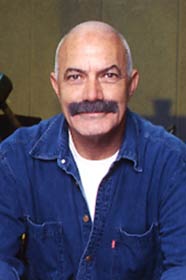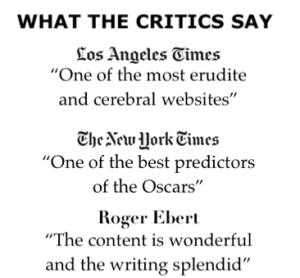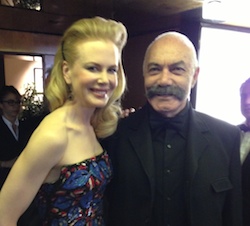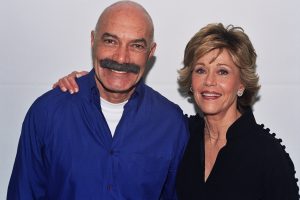With “Sin City,” his pulp noir version, based on Frank Miller’s graphic novels of the same name, Robert Rodriguez has made a bold movie that relies on his multiple skills as producer, director, cinematographer, editor, composer, and supervisor of special effects.
Our Grade: B (**1/2* out of *****)
To be sure, Rodriguez has not done it alone. Out of respect for Miller’s source material, he insisted on sharing directorial credit, which forced him to resign from the Directors Guild of America, when the organization was reluctant to grant dual credit. The atmospheric music is also a production of collaboration between Rodriguez, John Debney, and that noir expert Graeme Revell.
What makes “Sin City” different in the current movie scene is its unified conception, from the storytelling to the visual design to the acting to the special effects. Unlike other adaptations of comic strip books to the big screen, “Sin City” doesn’t pretend to be what it is not. In this respect, the movie might be the most faithful rendition of a comic book, bringing the right visual and technical analogues to illustrate the literary material.
“Sin City” benefits from an extremely gifted and large ensemble, headed by Bruce Willis, Mickey Rourke, Clive Owen, Rosario Dawson, Jessica Alba, Benicio Del Toro, Michael Clarke Duncan, Josh Hartnett, Michael Madsen, Nick Stahl, and others. Some of these actors, particularly Willis and Rourke, do their best work in years, and Owen again proves that he’s cut for playing leading men and ready for international stardom. “Sin City” is one film that, despite limited characterization (a result of familiarity with the noir gallery to types and stereotypes, could be talked about in terms of acting—real, not cardboard, acting.
It’s been a long time since we saw such a stylized American picture. Indeed, aestheticism is carried to an extreme, with a predominantly black-and-wide screen, occasionally splashed by the hot colors of red (for the dames’ dresses and lipstick, and, of course, the spurting blood) and yellow, in the sequences featuring Nick Stahl as a dangerous pedophile named Yellow Bastard.
Based on three of Miller’s stories: The Hard Goodbye, The Big Fat Kill, and That Yellow Bustard, the narrative is necessarily fractured and episodic, but it is not a patchwork. Instead, the filmmakers successfully interweave the thematic triptych and dozen characters into a coherent, fluently told story that’s unified by an overall visual conception and smooth transition from segment to segment.
As the story begins, viewers are told: “Walk down the right back alley in Sin City and you can find anything.” The town is populated with the usual noir suspects: Tough guys, desperate vigilantes, corrupt cops, sexy and brokenhearted dames. Hard-boiled to the core, “Sin City” employs as its dominant motifs revenge, of the most brutal kind, and redemption, through love. It’s a universe of a few unlikely, reluctant heroes, trying to do the right thing in an amoral city that does not care.
Often suspenseful and searing, the shockingly violent stories, plucked right off the comic book pages, are told with verve and invention. Using cutting-edge digital filmmaking, Rodriguez has pasted the urban tales of louts, lugs, heroes and hussies to the screen without losing any of the comic’s silhouetted look and staccato rhythms. “Sin City” is brought to life through light and shadow, clipped dialogue, stylized acting, and above all, visual splendor, a product of Rodriguez’s imagination, helped immensely by the art, sets, and costume designers, Jeanette Scott, Rob Simons, and Nina Procter, respectively.
The central story follows Marv (Mickey Rourke), a tough street fighter who has always played it his way. Marv takes home a beautiful hooker named Goldie (Jaime King), only to find her dead in his bed in the next morning. To avenge the loss of the only love he has ever known, Marv scours the city aggressively, wreaking havoc in every possible direction.
Then there’s the tale of Dwight (Clive Owen), a private investigator perpetually trying to leave trouble behind, even though it won’t quit chasing after him. After a cop is killed in Old Town, Dwight stops at nothing to protect his friends among the ladies of the night, particularly Gail (Rosario Dawson in a sexy outfit).
Finally, there’s the yarn of John Hartigan (Bruce Willis), presumably the last honest cop in Sin City. With just one ticking hour left to his career, he’s going out with a bang as he makes a final bid to save the eleven year-old Nancy from a sadistic pedophile Roark Jr. (Nick Stahl), son of Senator Roark (Powers Booth).
The film is not without problems, some of which a direct result of the source material. Some may find “Sin City” to be repetitious in ideas and images. Others might complain about the narrow range of characters, all of which come from the noir domain.
Still others might complain that the film is too dizzyingly violent, and that the filmmakers take special relish in depicting brutality too graphically. I am not among those critics for two reasons. First, the violence is inherent in the graphic novels, and, second, it is done in a comic, semi-caricaturistic way.
How else can you explain Benicio Del Toro’s character, Jackie Boy, the once noble, now corrupted cop who stirs up a whole lot of trouble in Sin City’s Old Town. Watching Del Toro transform into a raging beast of a man, and playing his scenes, as a dead man with a gun muzzle seared through his head, is a riot. (Tarantino, who gets credit as a “guest director” reportedly, staged one of those scenes). A selfish madman, Jackie Boy is a man with license to kill, the perfect movie villain. Del Toro is an unusually gifted physical actor, who uses his formidable presence to great advantage; just note the way he moves or talks.
Peaking after an hour, with a climax depicting Marv as a hulking half-man, half-beast, the story inevitably sags in the later chapters. However, the last reel, in which Hartigan confronts Nancy as a mature woman, still aching with love for him, is particularly good, and emotionally touching. And the very ending, while downbeat, is congruent with the proceedings, and satisfying, too.
Known as the sweetheart of Sin City, Nancy Callahan is seen in two incarnations. First, she is an adolescent girl in danger. Then, she is an alluring 19 year-old exotic dancer who shines a light in the dark of the city. Nancy is the symbol of hope, the angel who tends to appear in the most disturbing places. She is played beautifully by both Makenzie Vega, as the doe-eyed, sweet little girl, and Jessica Alba, as the mature one. Soft and vulnerable, yet confident and strong when she needs to be, Nancy is the film’s strongest female character.
Willis is incredibly persuasive at playing the pain and struggle of an older cop knowing that he’s never going to be everything that he wanted to be. In his romantic scenes with Nancy, Hartigan’s looks are filled with the kind of love that burns and hurts.
Established in 1991 by Miller, Sin City is a town that exists literally and figuratively in black and white, a world every bit as stark and hard-edged on the outside as it is on the inside. It’s a place of contrasts between the corrupt, the power-hungry and the unredeemable on the one hand, and those still clinging to morals, hopes and dreams of love on the other. An imaginary metropolis with its own mores, the city is bursting at its seams with raw impulses and emotions.
The city is the product of the imagination and skilled pen of Miller, an iconoclast-player in the modern revolution in comic book storytelling, who had won literary acclaim, working on Marvel Comics’ “Daredevil” and the influential Batman graphic novel, “The Dark Knight Returns.” Miller’s mark on pop culture continued with the creation of such popular characters of the ninja assassin Elektra and the futuristic samurai Ronin.
In Miller’s city, there are no superheroes, just tough-guys, hard cases, guns, girls, lovers, and losers, all trying to make it through the dark night. Miller’s men are built like thick blocks of muscles, his women drawn with pure seductive voluptuousness, his city one of infinite alleyways, winding staircases and cold, steel monoliths. They explode off the page (and now screen) in riveting white-silhouetted drawings.
Like hardboiled novels and noir films of the 1940s and 1950s, “Sin City” took the comics into an off-limits realm, the quintessentially American urban frontier, a place where the dialogue is snappy, outlaws are perpetually fighting the system, and heated rage and sexual desire are buzzing under the cool surface. While the stories are filled with hardboiled thrills, they also draw on classic myths of revenge, tragedies that tackle themes of human loss, romantic love, and eternal yearning. The morality tales and love stories are interlinked and set in one dark city, which becomes a character itself in the film.
“Sin City” is a neo-old film noir about a slick, dark, make-believe world in which the heroes are snappy but the villains are snappier. As such, it’s an uncompromisingly dark and violent work that fits Rodriguez’s qualities like a silk glove. Never averse to risk-taking, Rodriguez has built a diverse output, ranging from the ultra-low-budget classic “El Mariachi,” to the horror film “From Dusk Till Dawn,” to the hit “Spy Kids” franchise.
Rodriguez claims that the books were so visually bold that all he wanted was to literally translate, not adapt, Miller’s raw, unaltered vision to the big screen. Indeed, Rodriguez has taken each frame of Miller’s books, with its black line and crisp silhouette, and turned them into thrilling moving images. In short, the filmmaker says: “I didn’t want to make Robert Rodriguez’s Sin City,’ I wanted to make Frank Miller’s Sin City.” To accomplish his goal, Rodriguez has brought his expert technical knowledge–lighting, cutting, photography, and visual effects–to make a movie that looks and feels exactly like the books.
No doubt, “Sin City” exhibits what could be called cinema of excess, an ultra-cool, stylized film in which every gesture and word are exaggerated by design, which might limits its potential commercial appeal.










